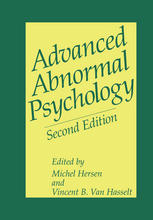

Most ebook files are in PDF format, so you can easily read them using various software such as Foxit Reader or directly on the Google Chrome browser.
Some ebook files are released by publishers in other formats such as .awz, .mobi, .epub, .fb2, etc. You may need to install specific software to read these formats on mobile/PC, such as Calibre.
Please read the tutorial at this link: https://ebookbell.com/faq
We offer FREE conversion to the popular formats you request; however, this may take some time. Therefore, right after payment, please email us, and we will try to provide the service as quickly as possible.
For some exceptional file formats or broken links (if any), please refrain from opening any disputes. Instead, email us first, and we will try to assist within a maximum of 6 hours.
EbookBell Team

4.7
96 reviewsAlthough senior undergraduate psychology students and first year master's-and doctoral-level students frequently take courses in advanced abnormal psychology, it has been almost two decades since a book by this title has appeared. Professors teaching this course have had a wide variety of texts to select from that touch on various aspects of psychopathology, but none has been as comprehensive for the student as the present volume. Not only are basic concepts and models included, but there are specific sections dealing with childhood and adolescent dis orders, adult and geriatric disorders, child treatment, and adult treatment. We believe the professor and advanced student alike will benefit from having all the requisite material under one cover. Our book contains 26 chapters presented in five parts, each part preceded by an editors' introduction. The chapters reflect updates in the classification of disorders (i. e. , DSM-IV). In Part I (Basic Concepts and Models), the chapters include diagnosis and classfication, assess ment strategies, research methods, the psychoanalystic model, the behavioral model, and the biological model. Parts II (Childhood and Adolescent Disorders) and III (Adult and Older Adult Disorders), each containing seven chapters, represent the bulk of the book. To ensure cross-chapter consistency, each of these chapters on psychopathology follows an identical format, with the following basic sections: description of the disorder, epidemiology, clinical picture (with case description), course and prognosis, familial and genetic patterns, and diag nostic considerations.